Publication
Article
Urology Times Journal
Analyzing urologists’ 2021 MIPS performance
Author(s):
Here’s how the specialty fared vs other eligible clinicians.
The Quality Payment Program (QPP) seeks to “reward high-value, high-quality clinicians with payment increases” by reducing payments to clinicians who don’t meet performance standards and redistributing those reduced payments.1 Eligible clinicians are in the seventh performance year of the QPP, and most urologists are still compelled to participate through the traditional Merit-based Incentive Payments System (MIPS) pathway. (Advanced alternative payment models [APMs] are not a viable option for most urologists.) The COVID-19 pandemic has had a direct impact on MIPS performance through policies that began in 2020 and continued through 2022, automatically reweighting the Cost category and providing the option for reweighting the Quality category. This has made it potentially easier to achieve higher scores and, in turn, potentially reducing the amount of money available to redistribute to the higher performers. The Centers for Medicare & Medicaid Services (CMS) recently published provider-level data for the MIPS 2021 performance year (the most recent year available) that reflects performance by clinicians, groups, and specialties.2 As I have done in past years, in this article, I will examine urologists’ MIPS performance in 2021 relative to other eligible clinicians, with an emphasis on the Quality category and how this might be relevant for the future.
Overall, participation in traditional MIPS dropped sharply in 2021. There were 595,988 individual clinicians in 85 specialties with a final MIPS score reported by CMS in 2021, which was down 15.4% from the prior year. The mean final MIPS composite score for the entire pool of clinicians was 90.0, essentially unchanged from 2020, when COVID-19 reweighting policies were first introduced. The data include 6231 individual clinicians identified as urologists (down from 6321 in 2020), with a mean final score of 90.8. A total of 5008 (80.4%) urologists achieved a score of 85 or greater and qualified for the exceptional pool vs 79.8% of all clinicians. A total of 3.3% of all clinicians and 1.5% of urologists scored below the final score threshold for negative fee schedule adjustments (MIPS score of 45) in 2021, both nearly double the proportion from the prior year. The performance metrics of some high-volume specialties are included in Table 1.2
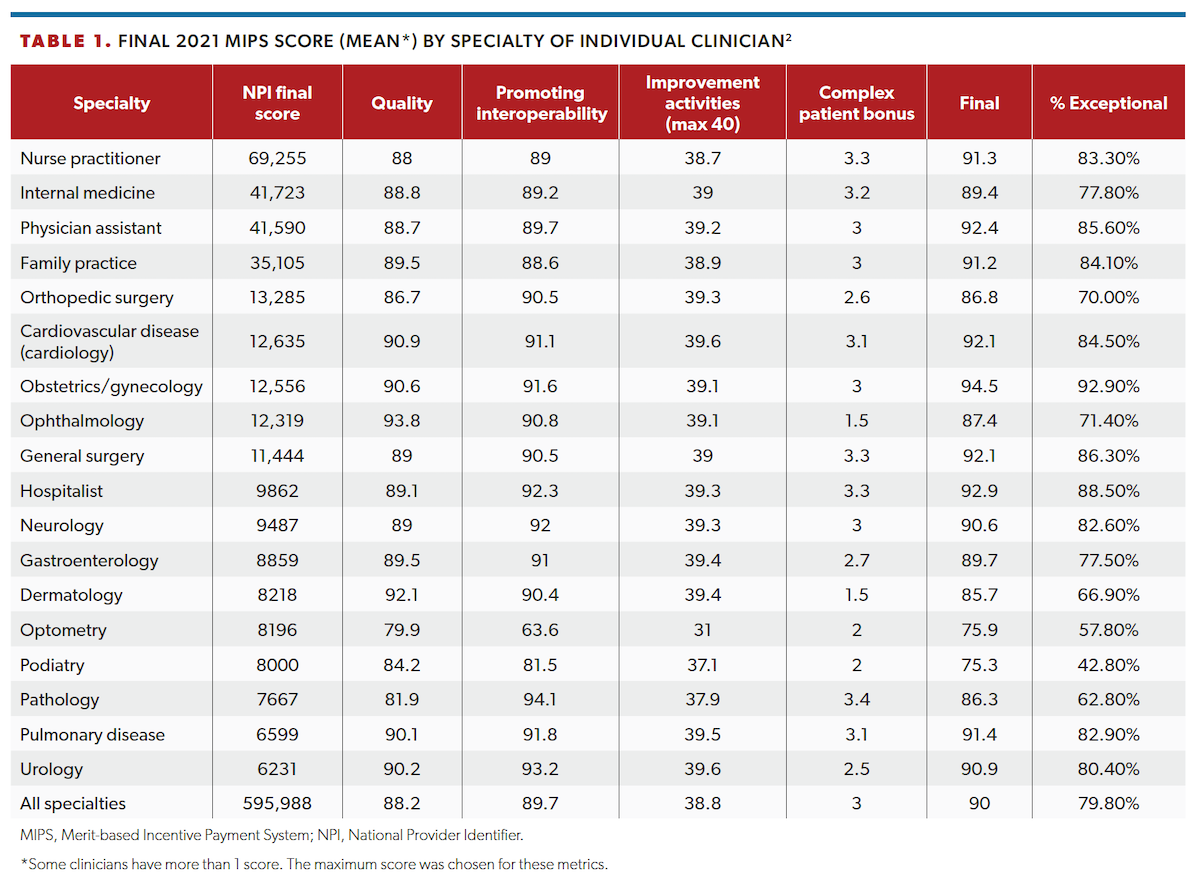
Remember that in traditional MIPS, clinicians may choose to report as individuals, as a group, as part of a MIPS APM, or in any combination. It behooves those who can report via more than 1 method to do so, as CMS will take the highest of the scores it can calculate on submitted data. This can be tedious for very large groups, but the results speak for themselves. Urologists who were able to achieve MIPS APM scoring in 2021 had the highest mean final score (97.7), and those reporting as groups did significantly better (94.2) than those reporting as individuals (77.2), according to CMS data. Table 22 shows the breakdown of reporting sources for urologists who earned a MIPS final score in 2021.
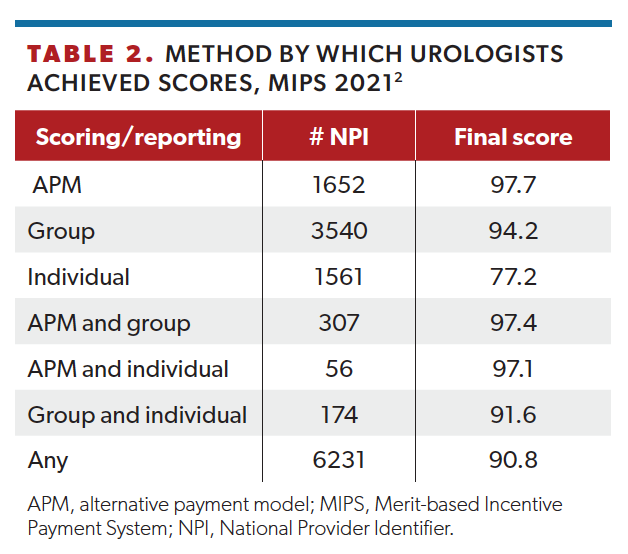
The Quality category continues to be the area offering the greatest challenge to high performance in the QPP, especially for specialists forced to report on “generic” measures to meet program requirements. In 2021, similar to 2020, CMS allowed clinicians to reweight (not count) the Quality category; the data reflect that 1446 of 6231 (23.2%) urologists achieved a final score with no contribution from the Quality category. Of those urologists in the majority who did submit Quality measures for credit in 2021, most continued to use the same generic measures as they have done in the past, despite the availability of some specialty-specific measures. In general, urologists underperformed compared with other specialties on generic measures and outperformed on many of the specialty-specific measures (Table 32). In 2023, more specialty-specific measures are potentially available for reporting than in 2021 (Table 42)— of course, depending on the clinician’s ability to work with a vendor who can report these measures. Remember that Qualified Clinical Data Registry (QCDR) measures must be reported through a registry, whereas MIPS measures can be reported through a registry or from an electronic health record (EHR). In my opinion, half of the 2023 measures most relevant to urologists are QCDR measures, and more are likely to come.
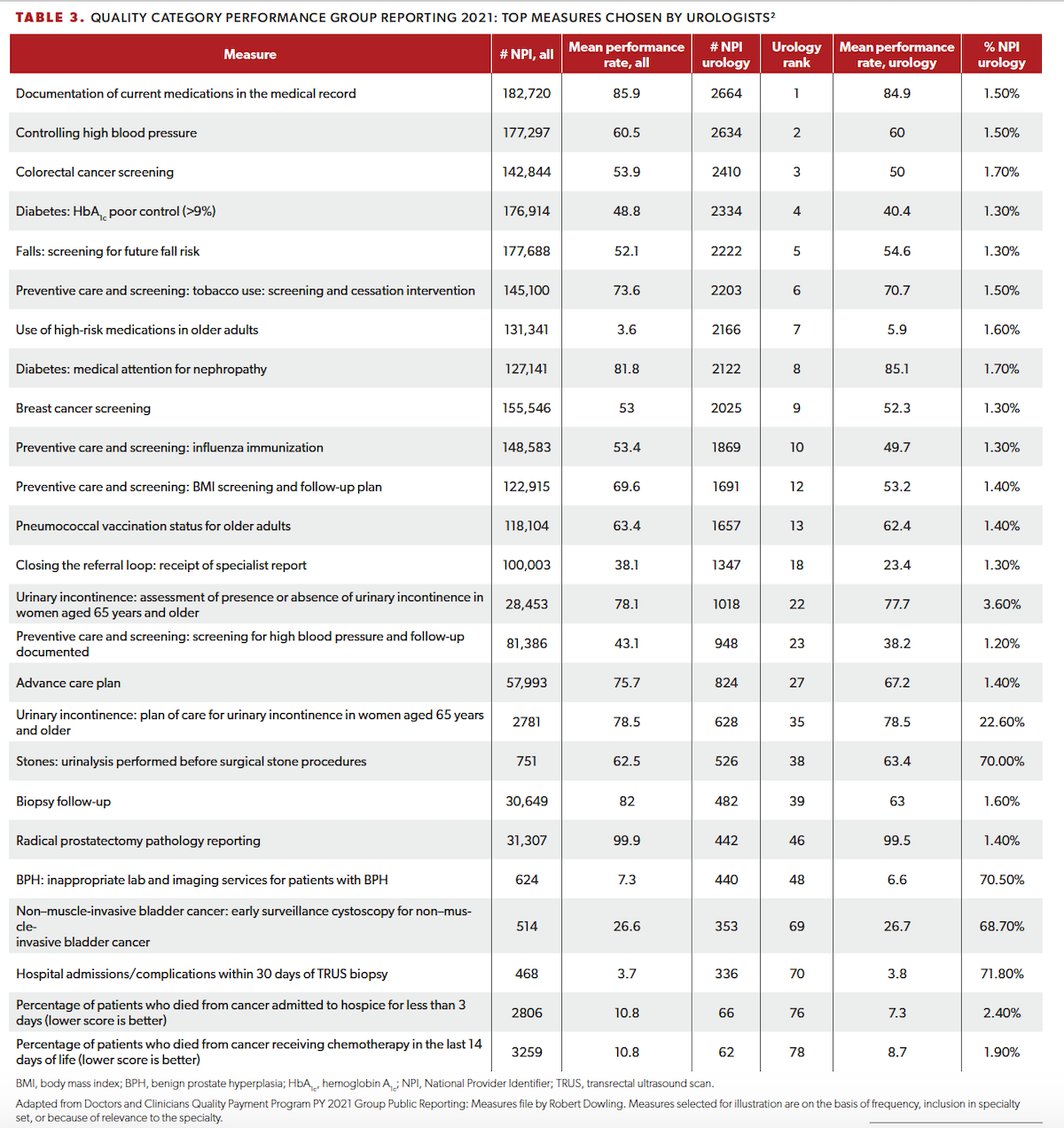
In the Promoting Interoperability category, urologists outperformed their peers in other specialties on Provide Patients Electronic Access to Their Health Information, and they underperformed relative to peers on Supporting Electronic Referral Loops (Table 52). The top Improvement Activity (IA) measures chosen by urologists were: (1) engagement of patients through implementation of improvements in patient portal; (2) provide 24/7 access to MIPS-eligible clinicians or groups who have real-time access to patient’s medical record; and (3) use of decision support and standardized treatment protocols. Use of telehealth services was the sixth most common IA activity chosen in 2021, down from fifth place in 2020. CMS did not publish measure-level data in the Cost category for the 2021 performance year because of the aforementioned automatic reweighting.
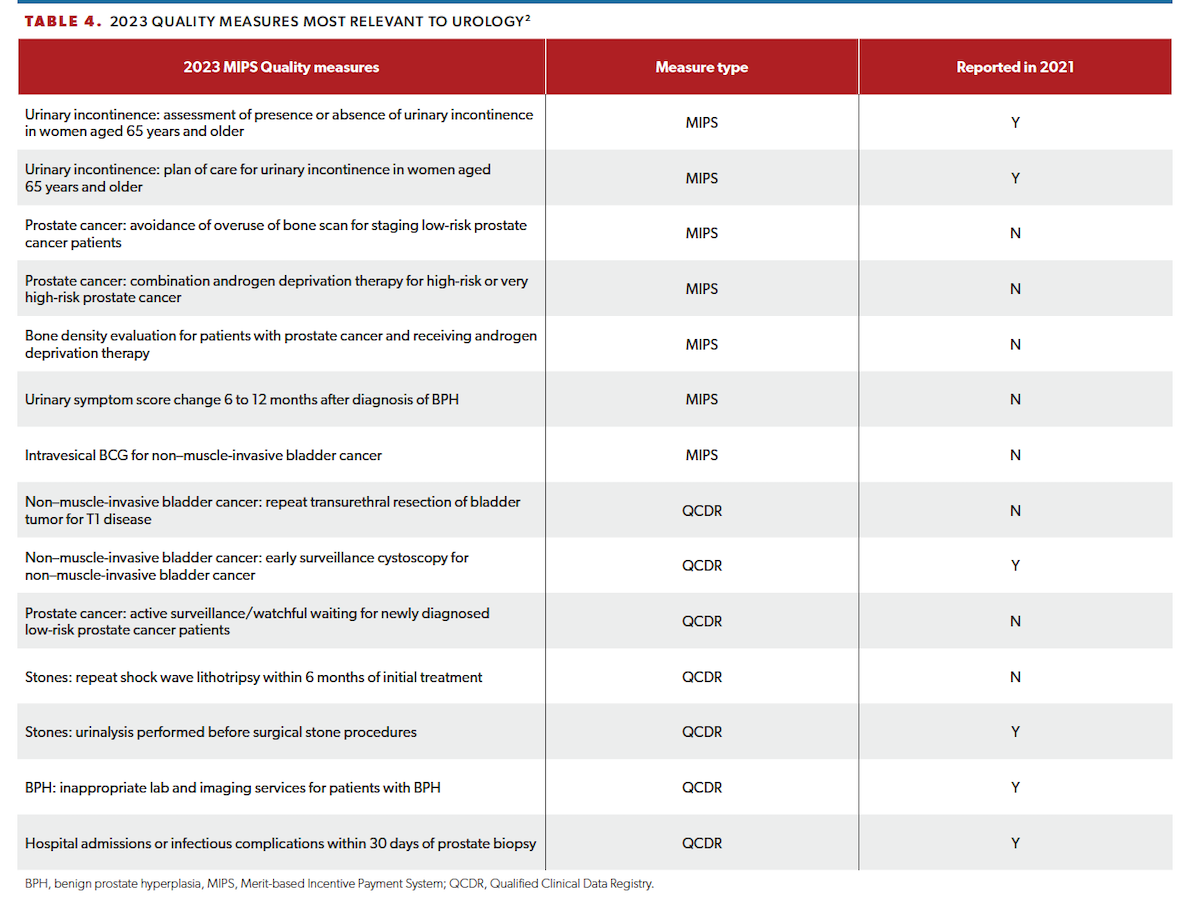
What does this mean for you and your practice? First, although most urologists in performance year 2021 scored well enough in MIPS to avoid a negative fee schedule adjustment in 2023, the fraction of clinicians and urologists who will be penalized nearly doubled compared with the prior year. This could theoretically result in more dollars to distribute to the rest of the MIPS clinicians and a higher (less modest) fee schedule adjustment than in previous years. In turn, this is important, as the pool of dollars for exceptional performance is set to expire. As I wrote last year, it is getting more difficult to score well in MIPS, and with inclusion of the Cost category comprising 30% of the final score, bigger fee schedule adjustments may be seen in future years.

Second, adoption of true urology-specific measures is improving but continues to lag use of generic measures. Most of the action in this area is with QCDRs, where development, approval, and implementation can be more rapid than with MIPS measures. If you haven’t already done so, you should consider moving toward using a QCDR for Quality measure reporting instead of relying on your EHR vendor for Quality measure updates.
Third, the data continue to show that urologists who submit as part of a MIPS APM, or as part of a group, score higher in the QPP than individual submitters. As traditional MIPS is eventually replaced by MIPS value pathways, you should expect to feel more pressure to submit data as a group. If you currently have the opportunity to report as both a group and an individual, you should do so to maximize your final composite score.
Finally, as I recently wrote, public reporting of your MIPS performance is done at the measure level; patients have access to this information in the form of “star ratings” on a user-friendly portal.3 For all these reasons, you should familiarize yourself with your own MIPS performance data in the provider data catalog (bit.ly/3KbSjE5) or on Care Compare (bit.ly/3FXyGgF). Both sites allow you to search for your own information by National Provider Identifier or name. You can use the information in this article to compare your score with the average score of your peers and know where you stand.
References
1. Quality Payment Program overview. Centers for Medicare & Medicaid Services. Accessed March 27, 2023. http://bit.ly/42HOYnF
2. Doctors and clinicians datasets. Centers for Medicare & Medicaid Services. Updated February 16, 2023. Accessed March 27, 2023. https://bit.ly/3CZ9vqY
3. Dowling RA. Are you viewing your information on Care Compare? Urology Times.April 11, 2023. Accessed April 14, 2023. http://bit.ly/3mzzIZS
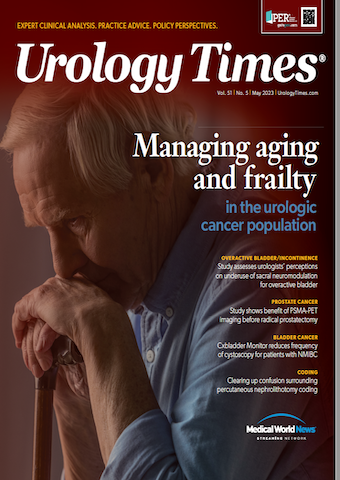
Newsletter
Stay current with the latest urology news and practice-changing insights — sign up now for the essential updates every urologist needs.




























